JRDG Company Special – Synergy, Synergy 2 and Synergy 2i
All Synergy models have the same cosmetics and dimensions. The info and technical differences are described further below.
Synergy 1 and 2i Extensive Review
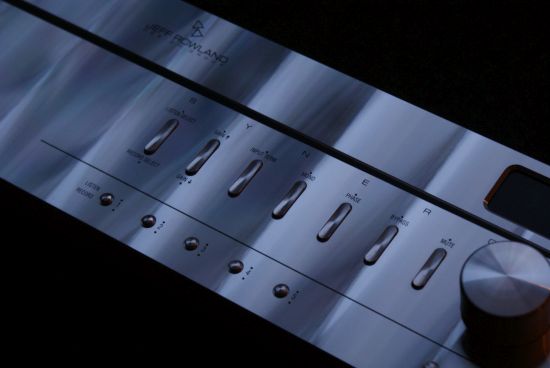
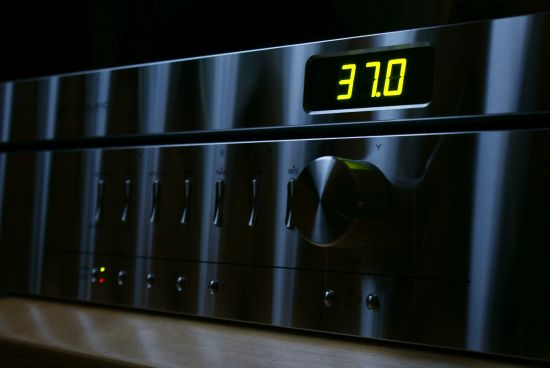
Green display means Synergy 2i.
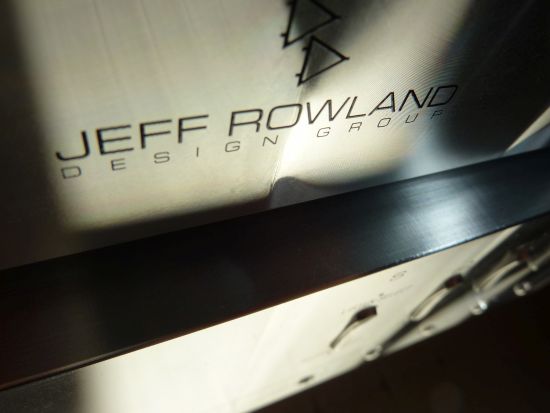
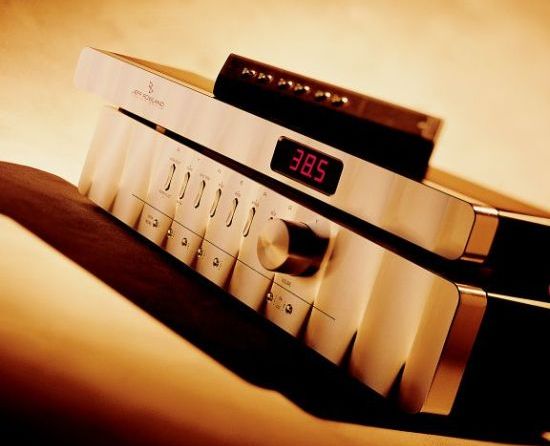
Red display means either synergy 1 or 2 (not 2i)
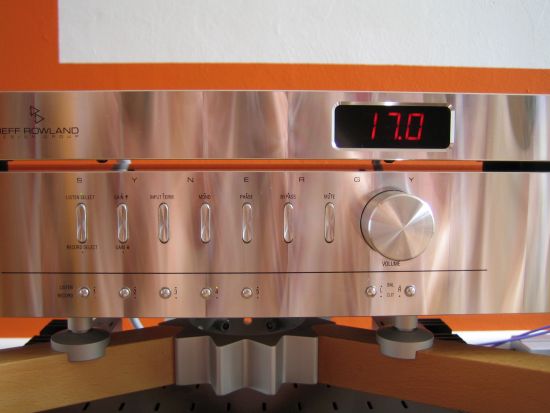
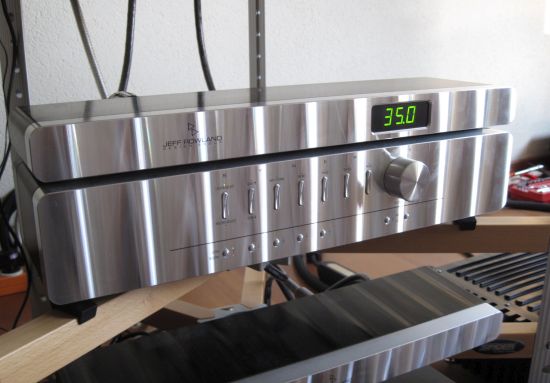
Above: Synergy 2i with green display, below Synergy 2i with blue display
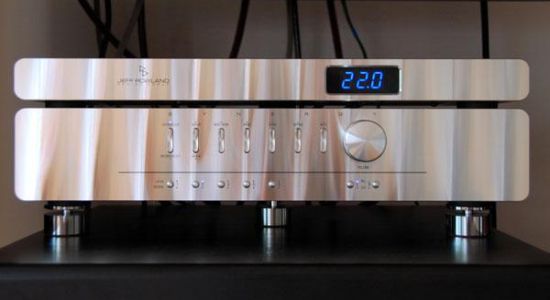
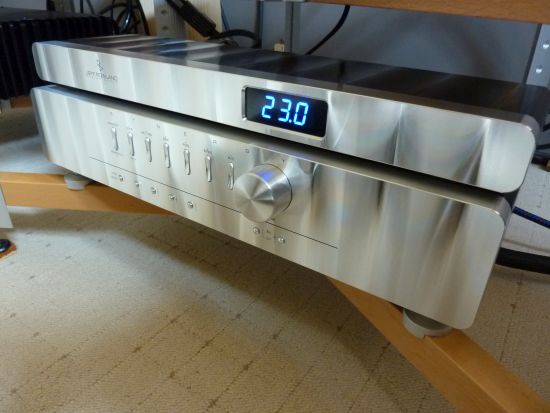
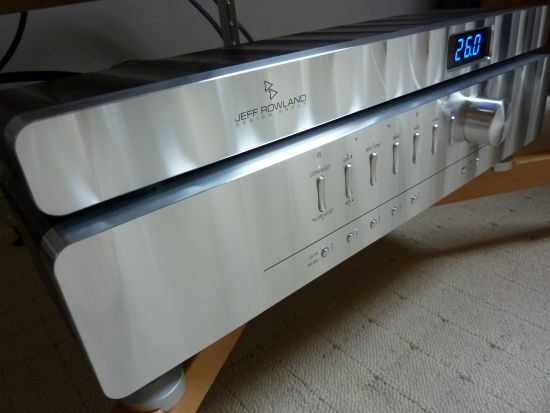
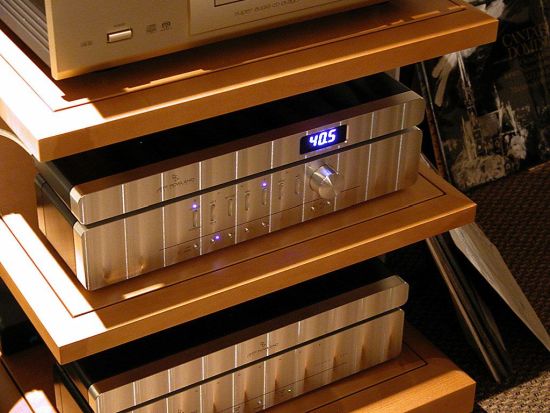
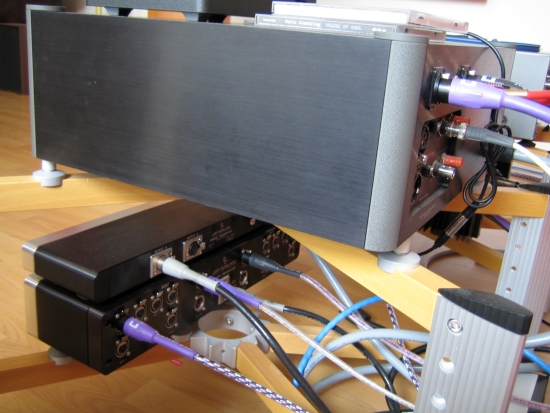
Above: Synergy 1 in a Finite Elemente Spider rack with a comparably monster sized Wadia 861 on top. The Synergy looks almost looks silly on the rack because it occupies only the front two struds, but the influcence on the sound is unmistakable. Especially the considerably laidback Synergy 2i really needs a Spider rack to sound its best.
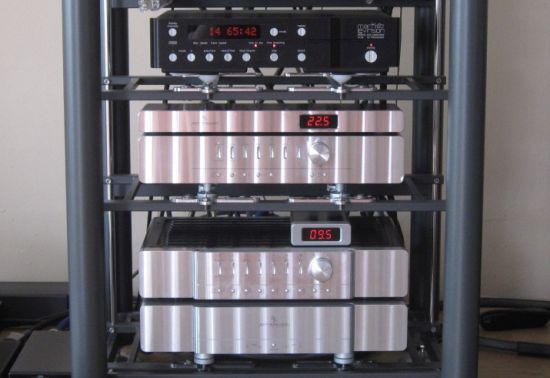
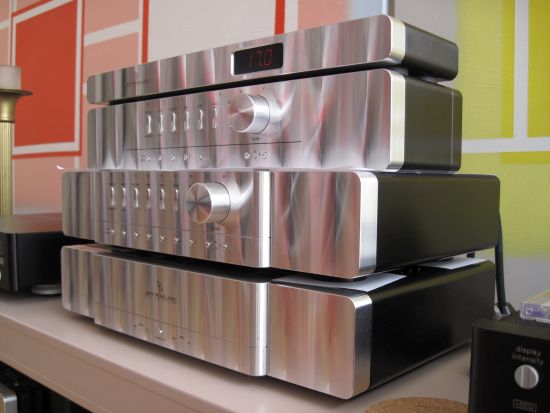
The front panels have exactly the same buttons in exactly the same places. The only differences are that the Coherence has two more inputs. Interestingly though, the software is the same with the result that for the Synergy when toggling throught the inputs using the remote control, you pass two empty places between the last available input and the first.
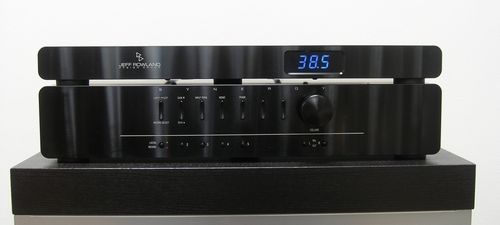
In Europe you mostly see the silver finish but it seems that in the US you see the black models more often, although still not nearly as much as the silver models.
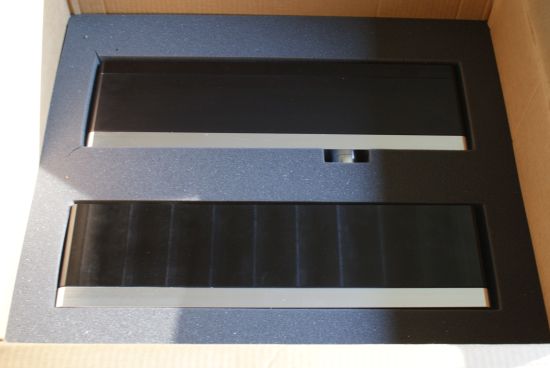
This is how the Synergy is packed inside its box. On the bottom and on top are equally thick layers of foam, making the packing bomb-proof.
Model Descriptions
Synergy
1996-1997
Retail price in 1997 in the Netherlands 7200 euro
The original Synergy was a new design. It has a red display, only has output transformers (no input transformers), a single set of main and record outputs and “SYNERGY PREAMPLIFIER” printed on the back panel.
Synergy 2
1997-2000
Retail price approx 7200 euro
The Synergy 2 was a refinement of the original Synergy 1 and had a red display, both input- and output transformers, a second set of main- and record outputs (all parallel) and either “SYNERGY PREAMPLIFIER SERIES II” printed on the rear panel or simply “SYNERGY PREAMPLIFIER” in case of an upgrade.
Synergy 2i
2001-2007
Retail price 7999 euro
This update replaces the original amplifier board within the Synergy and Synergy II with a new, surface mount designed amplifier board and green or blue display and indicators. The majority of Synergy IIi preamplifiers have the words “SYNERGY PREAMPLIFIER SERIES IIi” laser engraved on the rear panel. Original Synergy models could also be updated and in these cases the lettering on the rear panel would not be changed.
Synergy 1 inside

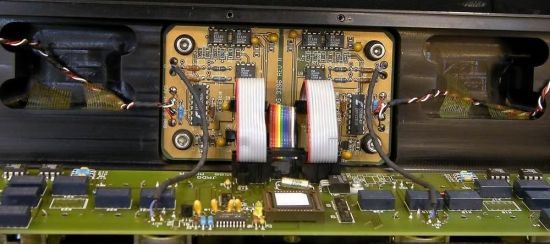
The original Synergy is comparable in overall build with the later Synergy models. Apart from the circuit board colour, the most obvious difference is the original model’s lack of output transformers.
Synergy 2 inside
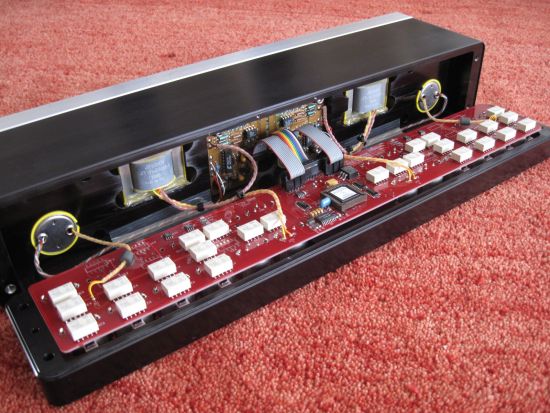
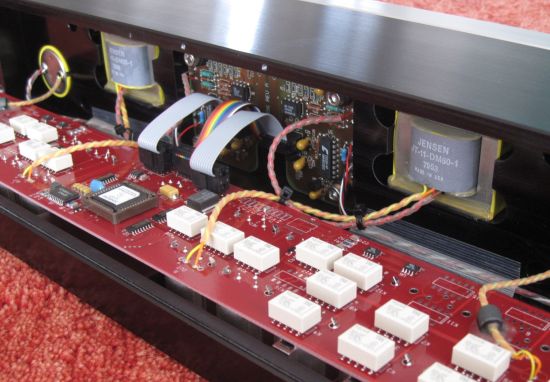
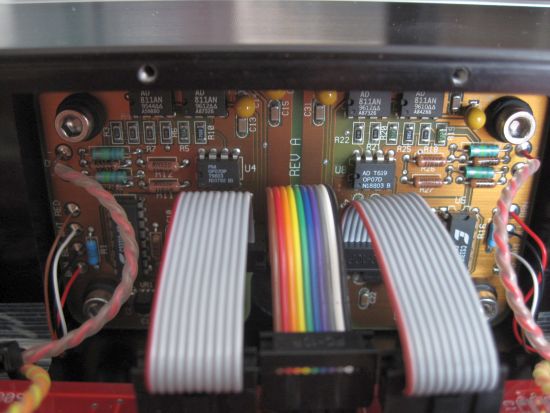
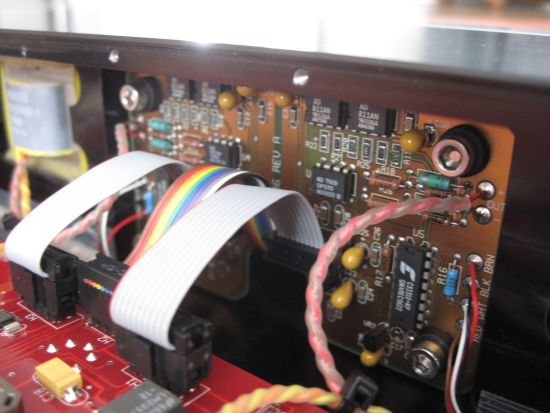
The actual preamp board, displayed larger than life (actually no more than 10cm wide)
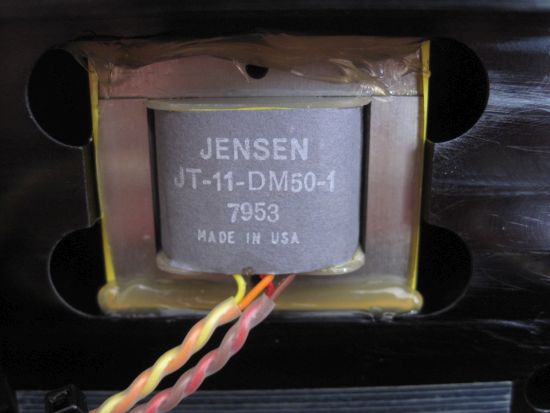
Above: Jensen output transformer (one for each channel)
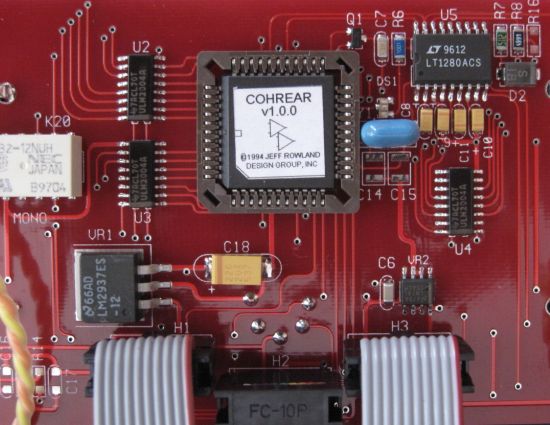
Yup: the Synergy runs Coherence firmware. This explains why, when toggling through the inputs using the remote control, there are two empty inputs after input 5 before it loops through to input 1 again.
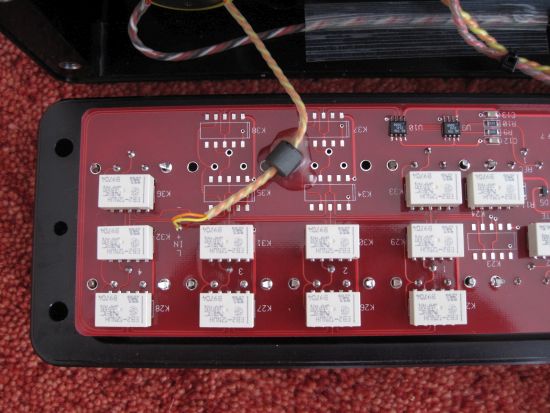
Above: rear panel input switching section
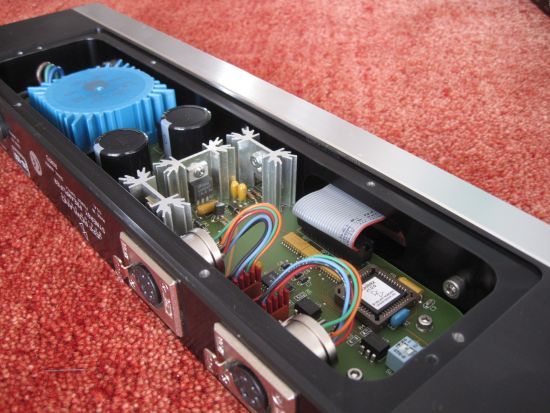
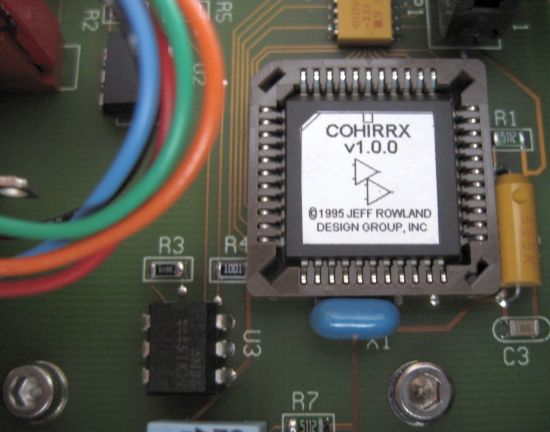
The IR receiver/display section inside the power supply also runs runs Coherence firmware.
Synergy 2i inside
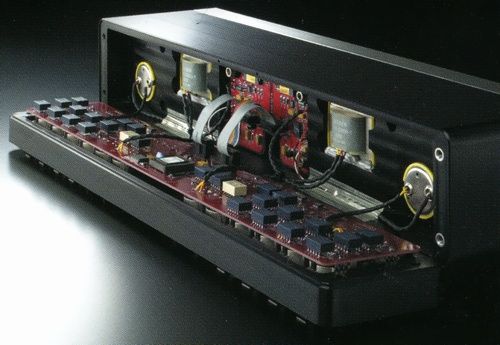
Apparently I never made pictures from the 2i’s insides and searching the net, the above picture is the only one that I can find! Isn’t that odd?
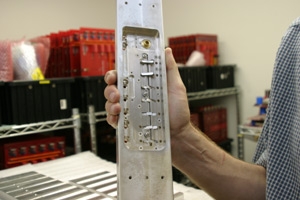
What I do have is the inside of a Synergy (model independent-) faceplate. Clearly visible are the backsides of the toggle buttons.
Power Supply Comparison
Synergy 1:

Synergy 2:

Synergy 2i:

The top green circuitboard belongs to the Synergy 1, the seemingly identical green one in the middle belongs to the Synergy 2. The bottom one with the red circuitboard finally belongs to the Synergy 2i. The circuit design for all three is very similar and only on close inspection there are minor differences, mainly in component choice. Biggest difference are the silver capacitors for the 2i but I there’s evidence suggesting they were either part of a modification or replacements for damaged ones.
Problem Solving
Coherence, Synergy, Concentra, and Concerto IR Remote Control lock-up
The remote controls for the above listed products have an internal capacitor that can cause the microprocessor to lock when the battery has been nearly drained. This problem will continue even after a fresh battery has been installed. This capacitor allows the remote to continue to function even after the battery has become very weak. The solution to this problem is simple: remove the new battery and allow the remote to stand overnight with no battery installed. Once the battery is reinstalled in the morning, the remote should function properly again.
Complete lock-up
It can happen that the Synergy locks up when you operate many buttons at the same time and also adjust the volume. All you need to do is unplug the powercord, wait for 10 seconds and reconnect. If you reconnect too quickly, the Synergy may not work. The same is true if you swap the power cable or change the position in the extensionblock. As a rule of thumb: always wait 10 seconds before reconnecting the power.
Technical Specifications
Synergy
Overall Gain (Adjustable for each input)
±20 dB relative to unity gain (0 dB) in 0.5 dB increments
Input Impedance (Adjustable for each input)
Unbalanced 36k or 600 ohms
Balanced 36k or 600 ohms
Output Impedance
Unbalanced 40 ohms
Balanced 80 ohms
Maximum Input Level
13 volts RMS at 0 dB gain
Maximum Output Level
13 volts RMS (24 dBm)
Output Noise Level
12 microvolts 20-20 KHz bandwidth, 0 dB gain
Signal To Noise Ratio
Greater than 96 dB
Channel Separation
Greater than 100 dB, 20-20 KHz bandwidth
Frequency Response
5 Hz-160 KHz, -3 dB
THD + Noise
0.0016% 10 volt output, 600 ohm load
Gain Range
63.5 dB, 127 equal increments
Gain Resolution
0.5 dB ± 0.03 dB over entire range
Channel Balance
± 0.03 dB throughout entire range
Dimensions
17.5 in W x 6.0 in D x 3.15 in H
44.5 cm W x 15.25 cm D x 8.0 cm H
Weight
24 lbs (11 kg)
Synergy 2i
Overall Gain:
Adjustable for each input, ±20 dB relative
to unity gain (0 dB) in 0.5 dB increments.
Input impedance:
Adjustable for each input.
Balanced 36k or 600 ohms
Unbalanced 36k or 600 ohms
Output Impedance:
Balanced 40 ohms
Unbalanced 80 ohms
Maximum Input Level:
13 volts RMS at 0 dB gain.
Output Noise Level:
10 microvolts, 20-20 kHz bandwidth, 0 dB gain.
Signal to Noise Ratio:
Greater than 96 dB.
Channel Separation:
Greater than 100 dB, @ 20-20 kHz bandwidth.
Frequency Response:
5 Hz – 160 kHz, -3 dB.
THD + Noise:
0.0012%; 10 volt output, 600 ohm load.
Gain Range:
63.5 dB, 127 equal increments.
Gain Resolution:
0.5 dB ±0.03 dB over entire range.
Channel Balance:
±0.03 dB throughout entire range.
Power Consumption:
25 watts maximum.
Preamp Weight:
24 lbs./11 kg.
Power Supply Weight:
7 lbs./3 kg.
Preamp Dimensions:
17.5” (w) x 14.35” (d) x 5.75” (h)/
44.5 cm (w) x 36.2 cm (d) x 14.6 cm (h).
Power Supply Dimensions:
17.5” (w) x 4.8” (d) x 1.5” (h)/
44.5cm (w) x 12.2cm (d) x 3.8 cm (h).
More Synergy
Synergy 1 and 2i Extensive Review
Synergy 2 Extensive Review
Compared to Corus, Coherence II and Concerto
More Jeff Rowland
Jeff Rowland Company Special Main Page
Jeff Rowland Company Special Preamplifiers
Hi Christiaan,
I am writing to you from Argentina because I read your notes excellent notes on Jeff Rowland preamps.
I recently bought a Synergy 2 in black, which replaced an old krell kbl.
In what position should I adjust the gain to get the best sound quality?
The system consists of krell kps 20i delta 9 cd player, Jeff Rowland 8T, B&W 801 S3 matrix.
I would really appreciate your help!
Greetings
Carlos Mattar
Hi Carlos, the best gain setting depends on your personal taste. I know that some people prefer it a few clicks higher than neutral and based on your system I think you might feel likewise. Just go about it by ear, counting the clicks. Higher gain leads to a slightly leaner and more forward sound while less gain leads to a smoother and more relaxed sound. In any event, please note that the gain returns to the neutral position after the power has been disconnected. Another way to improve the perceived speed and attack is to use hard couplers instead of the standard viscous rubber pads.
Hi, would you happen to know if the Synergy 2 could be easily converted to 120V from 220V? I mean a simple rewire or the transformer needs to be replaced? Thanks.
I believe there’s an input power switch on the inside next to the transformer inside the display unit. Just unscrew the bottom plate and you will have full access.
Hello Christian,
What is the best way to connect Synergy 1 with a BPS 1?
I bought a used BPS 1 and the former owner had not a Cardas 5-pin umbilical cable, instead he had a phone type cable connecting the multi-pin port of BPS 1 to the 5-pin XLR female socket of Synergy power supply.
This cable assembly is similar to the connection cable between indicating screen box and BPS of Coherence II with modifying the one cable end to 5-pin XLR male instead of phone type.
Anyway the preamp operates properly, but is O.K. in audio perspective?
The other thing I noticed, if you want to connect the XLR sockets between Synergy power supply and BPS 1 you need a umbilical cable ending both sides in male 5-pin XLR not like the supported Cardas male-female, this mean that you have to construct one?
Sorry for the long shot, any help will be appreciated.
Best regards
Nikos from Greece
Hi Nikos, it’s a long time ago that I used a Synergy and BPS and I forget the specifics. I do know that Jeff used to do custom modifications, and I can confirm that the connection method can seem counter-intuitive, but works nonetheless. The best advice I can give is to ask Jeff himself.